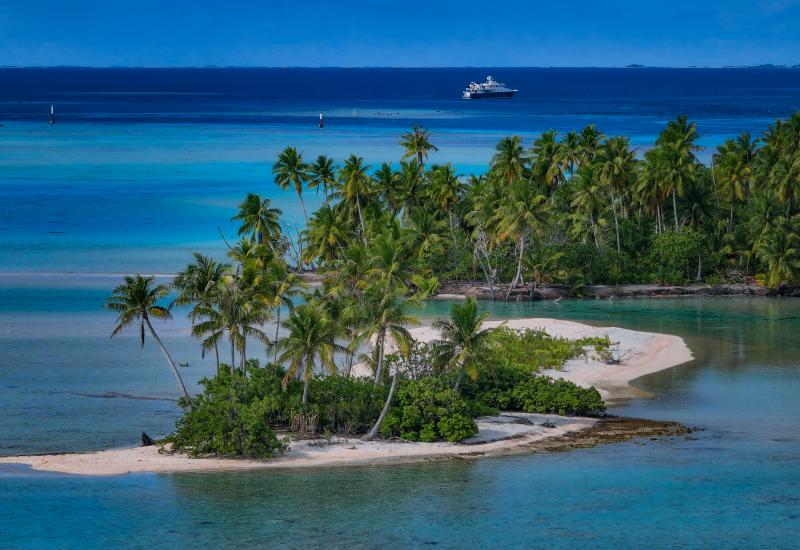Five Great Shipwrecks to Explore in Grenada
The tiny island nation of Grenada is known as the Shipwreck Capital of the Caribbean for good reason. The warm, crystal blue waters boast intact wrecks and thriving reefs accessible to divers of all experience levels.
As someone who typically “isn’t that into wrecks,” I was thrilled by how much I loved these dives. The intact structures, fun swimthroughs and loads of marine life combined with great conditions and viz to make exploring even more fun than usual! After a week of excellent, unlimited diving with Sandals Grenada, these are the ones I recommend you add to your ‘must-dive’ list.
1. Bianca C.
Dive Level: Advanced

Tiffany Duong/Ocean RebelsThe massive Bianca C. wreck is largely intact, with original structures still visible.
Known as the “Titanic of the Caribbean,” this 593-foot ship is the largest diveable wreck in the Caribbean and consistently ranks as one of the top 10 best wreck dives in the world.
The Bianca C. had a storied history above the water—including several names, time spent as a luxury cruise liner and a hospital ship, and sinking twice. After a boiler room explosion in 1961, the vessel sank (for the second and final time) upright in 165 feet of water. When you drop on the ship, you’ll hit the stern at 120 feet. “It’s like going into the great abyss,” said Sandals Grenada dive instructor Curtis Bailey. “You see nothing, and then boom! There she is.”
Many original structures remain intact, giving divers the opportunity to “swim” in the ship’s swimming pools at 130 feet. Divers will want a light for this dive, which is advanced due to currents as well as depth. Look for sea turtles, octopuses, horse eyed jacks, grouper and barracuda throughout the wreck. In the blue, scan for eagle rays and reef sharks.
2. Veronica L.
Dive Level: Beginner

Tiffany Duong/Ocean RebelsDive instructor Curtis Bailey swims through a fish storm on the deck of the Veronica L. wreck.
Resting at 52 feet, the Veronica L. is a great wreck dive for novices. The back half is shaped like a large open box: You can swim over the walls and “into” the box without having to penetrate the wreck, letting new divers explore while still remaining “contained.”
There’s a beautiful ladder structure on the top of the ship encrusted with coral growth. If you peek through a window on the starboard side, towards the bow, you'll see a room lit up by sunbeams with a perfectly-placed conch shell on a table. This was my favorite snapshot.
Pufferfish, creole wrasse, frogfish and moray eels call this wreck home. Look for the endangered maze and brain corals on the ship walls. If you’re doing this as a night dive, hawksbill sea turtles are common encounters.
3. MV Shak’Em
Dive Level: Advanced

Tiffany Duong/Ocean RebelsDivers can swim along the deck corridors on the MV Shak’Em.
Originally a cargo ship, local lore says the MV Shak’Em sank when its final cargo of cement bales were loaded haphazardly and shifted mid-transit. You see these clearly when you’re diving the wreck.
Today, she sits upright in 100 feet of sand. This and the tight swimthroughs are what make her an advanced dive, as the water is clear, and currents are usually mild. On a good day, you can see the wreck from the surface. Many divers swim along the two deck corridors and drop down to see the propellers in the sand. Look inside for slumbering sea turtles, as well as octopus, barracuda, seahorses and rare black coral.
4. Tyrrel Bay
Dive Level: Novice

Tiffany Duong/Ocean RebelsCurtis Bailey from Sandals Grenada hangs out under the structures of the Tyryl Bay waiting for divers to descend.
“This was my favorite wreck because there are so many remnants to see, and you can go in and out of it,” open water diver Jenna Lang told me. “There are the windows, the deck chair and a beautiful reef right next to it. And I felt safe exploring all of it.”
She’s right. The Tyrrel Bay is a really cool, fairly-new, easily-explored wreck. Donated by the United States, it was intentionally sunk in 2018 by the Grenadan Coast Guard and local dive shops to create an artificial reef. Today, its bottom sits in 75 feet of water. Divers can peek at the control panels through windows from the outside or play in easy swim-throughs. There’s a bonus wreck on the starboard side—an old Cuban vessel made of concrete with steel bars running through it.
For a double-hit dip, you can do the Veronica L. on the same dive. It’s an easy 15 to 20 minute swim from the Tyrrel Bay, and you travel over beautiful Boss Reef along the way. This shallow reef is full of endangered star and plating corals, yellow tailed snapper, lobster, eels, and more.
5. Hema I
Dive Level: Advanced
The 170-foot long Hema I sits on her port side in 100 feet of water off the south coast of Grenada, away from the majority of the island’s wrecks and dive sites. Since her sinking in 2005, several hurricane surges have broken apart the midship, but her bow and stern are still recognizable. Divers can explore the gangway and wheelhouse, and keep an eye out for the large number of nurse sharks sheltering under the ship’s panels.
“This is a real advanced dive,” said Bailey. “It’s on the Atlantic, meaning it’s not sheltered. It’s three miles offshore, and you cross big waves to get to the site.”
Conditions were too rough to dive it during my trip, and even when it’s diveable a negative entry is usually required. Beneath the surface, strong currents mean the visibility is always good because there’s no runoff from the rivers. The conditions can be so turbulent that the wreck sometimes sways underwater. These currents also bring marine life from the open sea, including eagle rays, sea turtles, reef and nurse sharks, barracuda and Atlantic SpadeFish.










